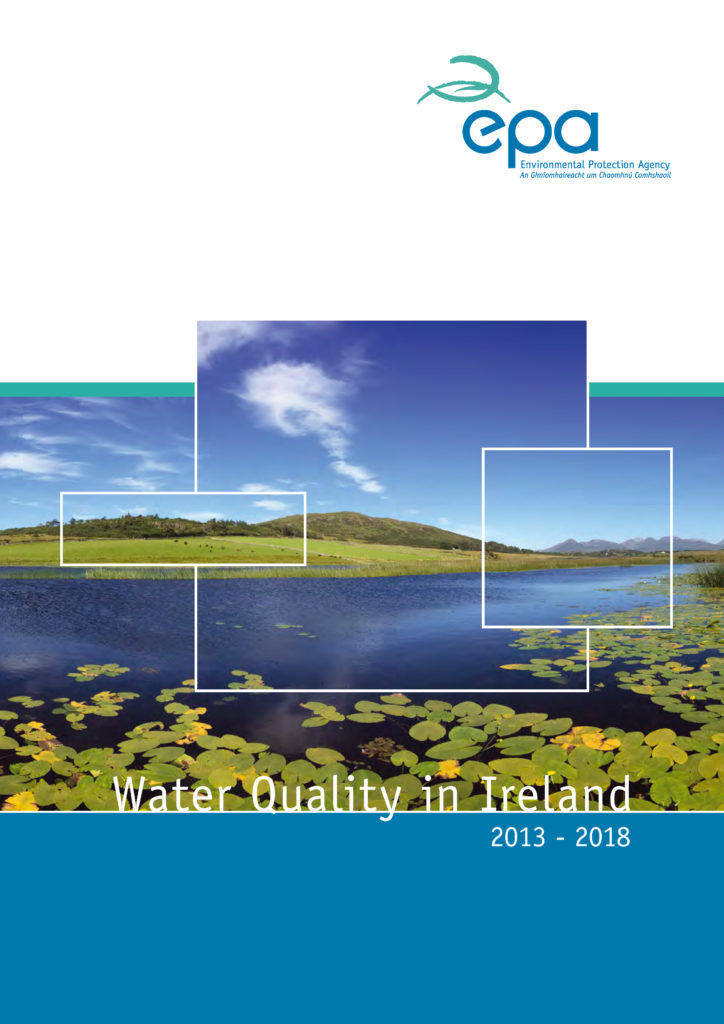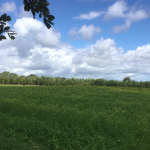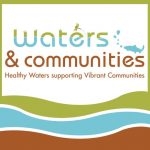Minister Michael Creed T.D. and Minster Eoghan Murphy T.D. launch…
Water Quality in Ireland 2013-2018 released: water quality is deteriorating
09 December 2019: The EPA has today published the Water Quality in Ireland Report for the period 2013-2018.
The key findings are:
- Assessment shows only 53% of our surface water bodies have satisfactory water quality.
- 92% of groundwater bodies, 80% of coastal waters, 53% of rivers, 50% of lakes and 38% of estuaries were found to be of satisfactory quality.
- Since the last full assessment, river water quality has got worse, with a net decline of 5.5% (128 water bodies) in the status of river water bodies.
- We are continuing to see a loss of the pristine (‘best of the best’) river water bodies. There are now just 20 pristine river sites down from over 500 sites in the late 1980s.
- The number of seriously polluted river water bodies (the ‘worst of the worst’) has started to rise – from 6 to 9 – after many years of an improving trend.
- The number of fish kills increased to 40 in 2018 after a historic low of 14 in 2017. It is likely that the hot summer and low flow conditions in 2018 had an impact on this.
Shane O Boyle highlights the main findings from the EPA’s Water Quality in Ireland 2013-2018 report in the video below.
— EPA Ireland (@EPAIreland) December 10, 2019
The report shows that river water quality is deteriorating,
with only 53% of our surface water bodies having satisfactory water quality. pic.twitter.com/BWYTGstNh5
Ireland now has just 20 pristine river water bodies – less than 1% of all the river sections examined by the Environmental Protection Agency. | https://t.co/oTJmbQ0ZPi pic.twitter.com/wKVX5PHTo4
— RTÉ News (@rtenews) December 10, 2019
Did you hear @morningireland today?
— EPA Catchments (@EPACatchments) December 10, 2019
Mary Gurrie, Water Programme Manager with the Environmental Protection Agency, discussed the agency’s latest report indicating deteriorating water quality across the country’s water bodies.https://t.co/k3Cx1KyPfB pic.twitter.com/oS8FyXvzu7
EPA Director Matt Crowe
‘Ireland has made commitments to protect and improve water quality, under the Water Framework Directive and the National River Basin Management Plan 2018-2021. The aim of European and National Water Policy is to get polluted waters clean again, and ensure clean waters are kept clean.’
‘However, the findings of this report indicate that water quality is getting worse after a period of relative stability and improvement. We now have an increase in the number of the most polluted river sites, and the number of rivers in poor ecological health is also increasing. Positive trends reported previously by the EPA have reversed. Not only are we failing to improve overall water quality, we are also failing to prevent further deterioration of our rivers.’
The main significant pressures impacting water quality in Ireland include agriculture, wastewater discharges, impacts to the physical habitat conditions including excess sediment (hydromorphology), and pressures from forestry activities.
Of particular concern in the most recent assessment is the increase in nutrients (nitrogen and phosphorus) finding their way into our water bodies. Agriculture and waste water are the main sources of nutrients. Over a quarter of river sites monitored have increasing nutrient levels and nutrient loads to the marine environment have also increased.
‘The overall increase in nutrient concentrations is a worrying development for our water quality. These excess nutrients come from human activities, predominantly our farms and waste water. We need to address the sources and the pathways by which these nutrients make their way into our rivers and lakes. Good water quality is essential for out health and well-being. The National River Basin Management Plan sets out a programme of measures to protect and improve water quality. It is essential that the measures required are implemented in order to avoid further deterioration and achieve the good water quality which people expect.’
Mary Gurrie, EPA Water Programme Manager
The report Water Quality in Ireland 2013-2018 is available on the EPA website and the accompanying data used in the water quality assessments are available on www.catchments.ie – on both the Maps and Data pages.
Further information: Niamh Leahy/Emily Williamson, EPA Media Relations Office 053-9170770 (24 hours) or media@epa.ie


Notes to Editor
Water Quality in Ireland Reports: The EPA has produced a number of periodic Water Quality in Ireland Reports on a three-yearly cycle, all of which are available on the EPA website. The Reports include an assessment of the water quality of our rivers, lakes, canals, groundwaters, estuaries and coastal waters.
Water Body: A water body in this report is an area of water which is usually either the whole part of a lake or coastal water, or a section of a river or an estuary (e.g. Lough Ree is one water body whereas the River Lee is divided into nine water bodies for monitoring purposes).
National River Basin Management Plan: The River Basin Management Plan 2018-2021 sets out the actions that will be taken to improve and protect water quality up to the end of 2021. Further information about the National River Basin Management Plan is available on the Department of Housing, Planning, Communities and Local Government website.
Water Framework Directive: The Water Framework Directive (WFD) is the primary Directive that sets out water quality objectives and common metrics for assessing and reporting on the quality of freshwater in Europe. These assessments are undertaken on a six-yearly cycle, with the outcomes reported by each country in their respective River Basin Management Plans.
Local Authorities Waters Programme: The Local Authorities Waters Programme (LAWPRO) is a local authority shared service managed by Kilkenny and Tipperary County Councils on behalf of all local authorities. It has recently commenced local assessments of the causes of water quality issues within the 190 areas set out in the River Basin Management Programme via the work of its catchment assessment team. and coordinates with the water quality work of Local Authorities through agreed regional structures, thereby providing a collaborative approach to river catchment management. It also seeks to engage local communities and promote public participation in the management of our water environment via the work of a team of water community officers.
Agricultural Sustainability Support and Advisory Programme: The Agricultural Sustainability Support and Advisory Programme is a programme to promote on-farm sustainability best practice to farmers. The programme is operated by Teagasc and the dairy cooperatives to provide advice and support to farmers in managing on-farm risks with specific focus on water quality. There are 20 advisors from Teagasc and 10 advisors from the dairy industry on the programme. Farmers can avail of a free and confidential advisory service within the 190 ‘areas for action’ set out in the River Basin Management Programme on a voluntary basis.
Significant pressures: Activities, such agriculture, wastewater discharges, impacts to the physical habitat conditions including excess fine sediment (hydromorphology), forestry, peat extraction and industry , that are identified as being significant contributors to surface water or groundwater bodies failing to meet their WFD objectives.
“Bad” category: The WFD category that indicates the worst surface water quality, which are regarded as being seriously polluted.
“Poor” category: The WFD category that indicates the second worst surface water quality, which are regarded as being significantly polluted.
“Pristine” waters: The best quality waters are assigned a high status WFD category, and a portion of these high status water bodies are defined as being pristine. Sometimes they are also referred to as “Q5” sites (achieving an ecological quality score of 5/5) or reference condition sites, and they are regarded as being largely un-impacted by human activities.
“Unpolluted” rivers: Includes those rivers assessed as being at high ecological status (an ecological quality score of Q5/5 or Q4.5/5) or good ecological status (an ecological quality score Q4/5).
www.catchments.ie: A collaborative EPA, LAWPRO and Department of Housing, Planning and Local Government website that is used to share data, information and resources on water in Ireland. It includes water quality assessments undertaken by the EPA for the Water Framework Directive.

www.catchments.ie: A collaborative EPA, LAWPRO and Department of Housing, Planning and Local Government website that is used to share data, information and resources on water in Ireland. It includes water quality assessments undertaken by the EPA for the Water Framework Directive.







